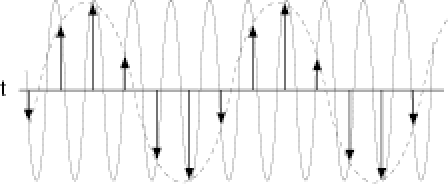Nyquist Theorem
The Nyquist theorem states that a signal must be sampled at least twice as fast as the bandwidth of the signal; otherwise, aliased products in the band of interest can distort the signal, causing loss of information. An alias is a false lower frequency component that appears in sampled data acquired at too low a sampling rate. The following figure shows an 800 kHz sine wave digitized by a 1 MS/s ADC. The dotted line indicates the aliased signal recorded by the ADC at that sample rate.

The 800 kHz frequency aliases back in the passband, falsely appearing as a 200 kHz sine wave. To prevent aliasing in the passband, a lowpass filter limits the frequency content of the input signal above the Nyquist rate. The analog bandwidth of the NI 4070/4071/4072 is 300 kHz and you can avoid aliased signals in that passband by sampling at the full rate of 1.8 MS/s.